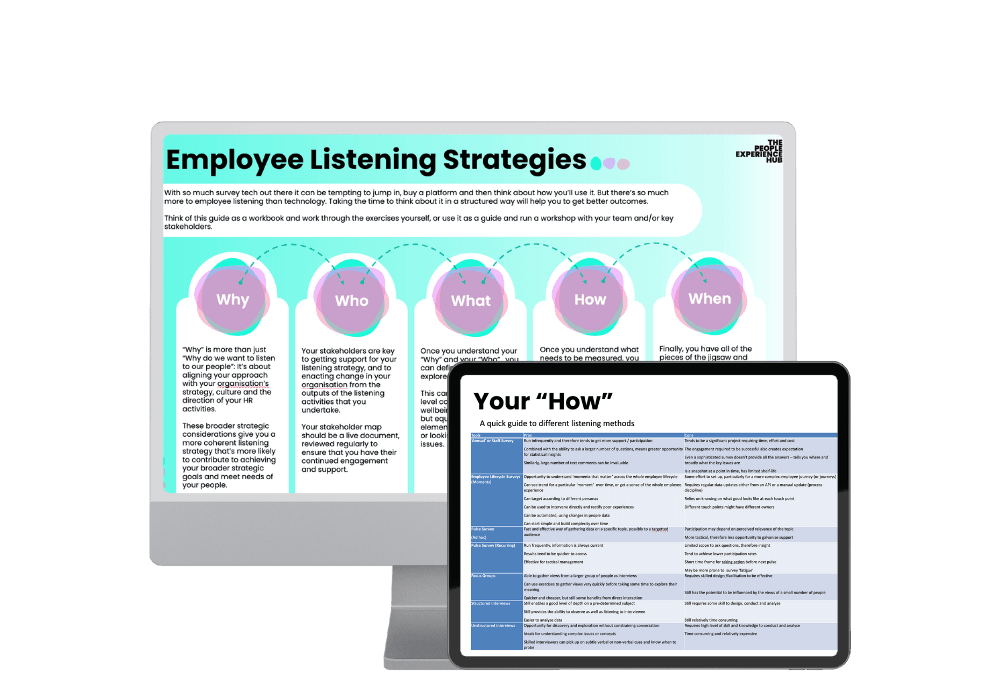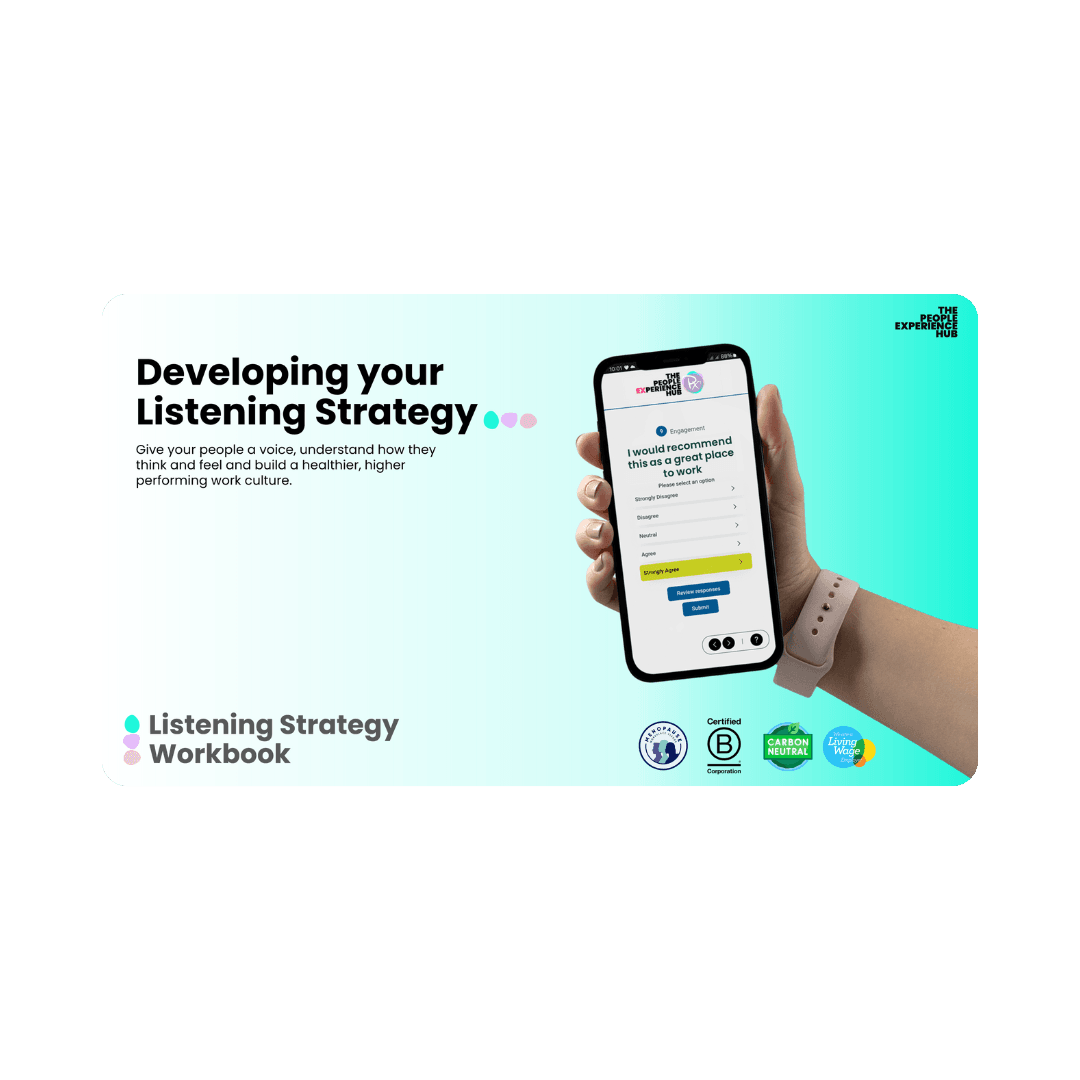Developing Your Employee Listening Strategy
A listening strategy includes, but is more than, a plan for what surveys to run and when. It should consider a range of listening approaches and methods, as well as the themes to explore, and the broader process that includes how that feedback will be used.
What is an Employee Listening Strategy?
An employee listening strategy is a documented, structured approach and plan for gathering employee feedback over time. The aim of a listening strategy is to develop insights that improve the employee experience and drive improved people outcomes such as engagement, performance and wellbeing while minimising noise, survey fatigue or cynicism.
A listening strategy includes, but is more than, a plan for what surveys to run and when. It should consider a range of listening approaches and methods, as well as the themes to explore, and the broader process that includes how that feedback will be used.
What is included in this guide?
As Simon Sinek suggests, we’ll start with why, and think about the overarching objectives for your Listening Strategy and its potential uses.
Next, we’ll look at the who: Not just the audiences that you want to gather feedback from, but the stakeholders that will need to be involved to make sure that the feedback leads to meaningful change.
This will help you to define more clearly what you might want to measure or understand better.
Finally, we’ll consider the how and when of your Listening Strategy. This covers a range of topics including methods, technologies, processes and data, as well as timings.

Why is a listening strategy important?
Imagine a complex organisation that makes and sells office supplies. On the surface, the organisation appears to be running smoothly, with KPIs pointing in the right direction and the business is enjoying a middling amount of market share. However, if we dig a little deeper, we find some real opportunities to improve:
- The sales team have recently got a new manager, who is implementing processes that are getting in the way of focusing on customer needs
- The head of product design is quashing ideas from the broader business, meaning it’s “their way or the highway”
- People from ethnic minority groups in the organisation are leaving at a higher rate than others, and whilst the company is aware this is happening – they don’t know why
- A new technology has entered the market. The organisation has a plan for implementing it across the business, but with no way of monitoring it.
- The senior manager within the warehouse has sent 4 surveys out in the last two months to their team about their experience – response rates are slipping and the insecure method of storing the data is introducing data breach risks
- The HR leadership team have created a plan for the next 12 months, and need a way to monitor it
- When job openings are posted, the company gets a high number of responses, but the drop-out rate within the hiring process is high
- The exec team are aiming for the company to increase market share over the next 3 years.
In this organisation, there’s a load of information or feedback out there, waiting to be tapped into or made sense of.
A listening strategy leads to more effective people (business) decisions
But how do you go about it? How do you make sure that you’re capturing it? How should you analyse it and make best use of it to make decisions?
Because this, ultimately, is why we collect employee feedback.
It’s about making decisions that lead to action.
Making good decisions means evaluating the information available and being clear about what is and is not a valuable course of action.
A listening strategy helps you to gather more focused employee feedback
Making sense of the feedback that’s available to you means evaluating it through the lens of people and business strategy. And the value of each of the following ‘use cases’ for employee feedback depends on your own strategic context:
- Developing or measuring the impact/effectiveness of people strategies, including but not limited to culture, EVP, ED&I, Wellbeing or Employee Engagement.
- Measuring the ‘on the ground’ employee experience, at a range of touchpoints across the employee journey (or journeys!), such as joining, onboarding, promotion or leaving.
- Evaluating or monitoring specific initiatives such as learning and development programmes or events.
- Measuring the people impacts of, or readiness for transformation and change programmes.
- Idea generation, or ‘crowdsourcing’, to gather the views of a wider audience before making decisions.
- Compliance monitoring, for example relating to health and safety or information security.
What might you add to this list?
As you can see, although employee listening might ultimately be owned by the People or HR team, there are many different reasons for gathering employee feedback , which sit across a broad range of stakeholders.
A listening strategy minimises the risks of inaction and survey fatigue
And with so much opportunity to gather employee feedback, comes risk: The risk that asking for too much feedback, too often (or at the wrong time), can create noise and confusion for employees, overwhelming amounts of information for your people team to deal with, and a failure to generate action. This, in turn, leads to cynicism and survey fatigue which can undermine your desired outcomes.
It’s important, therefore, to take care that every time you ask your people to take time out to give you feedback, whether it’s for a two-minute survey or a 90 minute focus group, you make that feedback work hard for your business.
This, ultimately, is why it’s so important to develop an employee listening strategy.
Convinced?
What’s in our Employee Listening Strategy guide?
The guide follows a basic process that will help you consider the why, who, what, how and when behind employee listening and develop your own strategy or approach. You can use it like a workbook and edit the slides or as a basis for a workshop.
Why: Is more than “why do we want to listen to our people?” (because if you’ve read this far, I’m sure you’ve figured that out!). It’s about aligning your approach with your organisation’s strategy, culture and the direction of your HR activities.
Who: Refers both to populations that you might need to understand the needs of, and to stakeholders in your listening strategy.
What: Is about the concepts and topics that you want to measure.
How: Relates to the methods, tools and processes for collecting and acting on your data.
When: Puts all of these pieces into a plan or timeline – taking into account the your business cycles and activities and the demands on others.

